
WITH this page, I am proposing/inaugurating a new Forgotten NY series, Greatest Hits, that will be appearing periodically, much like the series began earlier in 2024, One and Done, concerning NYC’s one-block streets; I got through Manhattan in three parts, though the other boroughs will be a bit longer, and for (relative) brevity’s sake, I’m leaving out one-block bits of numbered streets in each borough.
The premise of Greatest Hits is simple. I will take a neighborhood and visit the infrastructural items in each that intrigue me and capture these items with more photographic attention than I have devoted previously, shooting where possible from many different angles and focusing on detail I had not noticed before. While some of the items discussed have been mentioned in Forgotten NY (repeatedly) before, the website is now 25 years old, some are “late to the party.” What I consider a site weakness, and one that has been intractable thus far, is that pages I have written years ago are hard to find unless one gets really specific using the site function. In short that means I’ll be repeating some copy written before, but at the same time providing new comments where appropriate.
Flushing seems a good place to start, as while it’s one of NYC’s most crowded and bustling regions, infused with immigrations from South Asia beginning 40 years ago, it’s a very old town founded in the 1600s and chockfull of historic relics. I’m going to call this Part One, as I didn’t get to the highlights along Northern Boulevard at all, as ever-present weekend rain cut short my wanderings (it cleared up when I got home, but the game was on). What I may attempt is some midweek pre-sunset shooting, but I have to do some close editing work for 9 hours and after that, I’m more inclined to relax. But we’ll see. Persistent bad weekend weather may force my hand.
In what may become yet another series about pedestrian roadway and railroad crossings around town, I talked about the Murray Hill LIRR station overpass (41st Avenue and 150th Street) in April 2024. To begin today’s trip I exited the train here. It’s my least favorite station on my “home” LIRR branch, the Port Washington, because it’s in an open cut like the BMT N line Sea Beach stations in Brooklyn (which, thankfully, were renovated a few years ago. However, the Murray Hill station seams really impossible to spruce up. The walls are occasionally painted, but the paint usually peels quickly and the walls are blackened with mold. Additionally, neighborhood youth are ever ready to do their grim and unstoppable work of graffiti scrawlings. Drainage is poor, and the center median between tracks has large puddles after rainstorms. The station requires the kind of constant maintenance the MTA is unprepared to financially undertake.

I took some time to review some of the storefronts clustered around the station. This is a converted private dwelling at Barton avenue and Murray Street. I had to seek out what a croffle is; it is a combination croissant (I’m American, so I pronounce that CROY-sant) and waffle popularized in South Korea, similar to the “cronut” which combines the textures of a croissant and a donut. I have never had either.

This bar named “Paradise Alley” on 150th Street and 41st Avenue in Murray Hill always sounded vaguely familiar to me. The name has a long pedigree, but I can’t put my finger on where it originated.
“Paradise Alley” was the name of a theater piece in 1897. It was the name of a Broadway musical that played for a couple of months in two theaters in 1924. “Sunshine of Paradise Alley” was a 1926 feature film. In 1955, Allen Ginsburg used the phrase in his most celebrated poem, “Howl“: “….who ate fire in paint hotels or drank turpentine in Paradise Alley.” Carole King recorded a` song called “Paradise Alley” in 1968. It’s also the name of a Sylvester Stallone vehicle in 1978 that was set in the world of pro wrestling in the 1940s. The bar opened in 1979 so it was likely inspired by the movie. A number of bar/restaurants opening around the same time had the name including one in Harrisburg, PA. The name also found its way into William Kennedy’s “Quinn’s Book.” It’s the title of a song by Foghat. The two words together have probably been used thousands of times. But what was the first time?
It was also the name of a book by novelist/historian Kevin Baker, set during the 1863 Draft Riots in Manhattan. Kevin Baker supplied one of the blurbs on the back cover of Forgotten New York the Book, so I have reached out to him to see if he knows the origin of the name.
Finally, in the 1970s, Paradise Alley was shown on the Hagstrom maps in those years in Old Place, near the Goethals Bridge in Staten Island.
Meanwhile, as always, the floor is open in Comments.
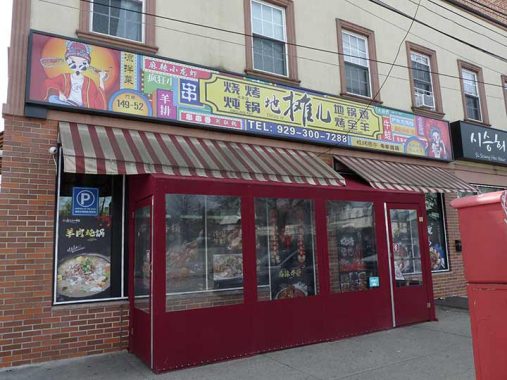
This brightly painted restaurant sidewalk sign at 149-52 41st Avenue attracted my attention…
…As did this likewise brightly painted karaoke exterior at Barton and Murray, across from the croffle joint.
The popularity of karaoke is baffling and amusing, for me at least, but I’ll leave it at that.
Voelker-Orth Museum
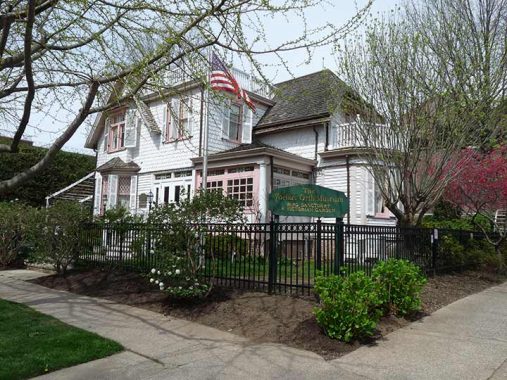
As stated previously I paid attention to getting these scenes from angles I hadn’t explored before, so be sure to click on each photo in each Gallery to view as large as possible.
A Victorian-era residence, the kind that have long been displaced in Flushing by boring, monolithic apartments and blond brick two-family homes (you know the type…concrete driveways and prominent water meters) has been preserved as a museum.
One of the rare survivors, a small, two-story house at 149-19 38th Avenue painted pink and white, has not only been allowed to stand but has been restored to full Victorian-era glory.
It begins with its resident for 69 years, Betty Voelker-Orth, who was born in the house in 1926 and lived there until 1995, when she died from complications from an automobile accident. In her will, Mrs. Voelker-Orth, an English literature teacher, nature lover and birdwatcher, had left her house to the Queens Historical Society, the Queens Botanical Society and the Audubon Society with the proviso that it be converted into a museum, bird sanctuary and Victorian garden, a specific type of garden employing colorful tropical plants in season, along with ornamental elements such as urns, benches, gazebos and statuary. Mrs. Voelker-Orth left a good part of her fortune, which amounted to millions, to the prospective museum as well.
Completed in 2001, the Voelker-Orth Museum stands as both a testament to Flushing’s old Victorian history and as a small nature retreat. You may contact the museum at 718-359-6227. Though the museum is open for tours Sundays and Tuesdays from 1-4 PM, the back garden is amazingly open very liberally, Monday-Friday from 10 to 4, and Sundays during tour hours, 1 to 4. The tour is worth it because the interior has been preserved and looks like it did in the mid-20th Century.

In Queens especially, utility poles are exceptionally burdened with power and electric lines, telephone wire (gradually lessening as wireless telephony has taken over) and cable TV wire (also increasingly unnecessary as streaming services controlled via the internet seem to be taking over). Within, say, 20 years, will there no longer be a need for wiring like this, at Parsons Boulevard and 38th Avenue?
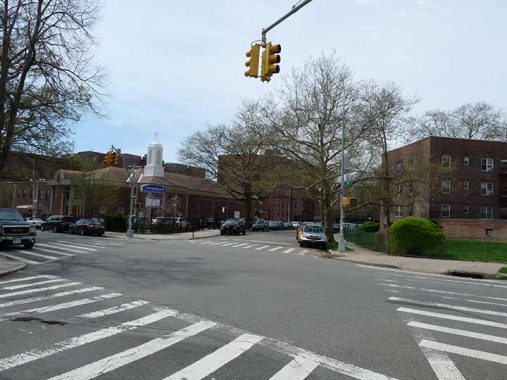
I walked west on 38th Avenue to reach the next Greatest Hit. The avenue takes a bend between two unnamed housing projects between 147th and 149th Streets. I had always thought that the bend appeared when the projects did. However, many years ago (I’ve been doing this awhile now) I was on a Flushing walking tour with the late Queens historian Jack Eichenbaum, who mentioned that the bend was there to get around a mansion. He probably said whose, but I forget.

You can do a lot of research with maps alone, though. I consulted this 1909 Queens map in Historic Map Works (which I try to evade nowadays, as they have made screen captured difficult by engineering an automatic zoom when I attempt it) but this edition by Bromley is invaluable). Before many Queens streets were numbered, they had names and while a healthy number of downtown Flushing’s streets have kept their old names, Lincoln Street was converted to 38th Avenue. You can see that it was interrupted by the estate of Robert E. Parsons. When the estate was divided into properties the mansion remained, but the city wanted to make Lincoln Street continuous; so, they simply bent it past the mansion, which still stood in 1940.
Parsons was a member of the family that originated one of Flushing’s first plant nurseries and for whom Parsons Boulevard was named.
Parsons and 37th
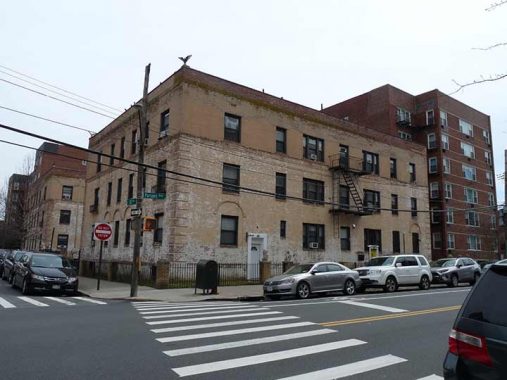
Now that I’ve mentioned Parsons, there’s what I consider a unique and unusual apartment building at the SE corner of Parsons Boulevard and 37th Avenue. In lieu of a name I call it the Parsons House. Lions guard its front entrance, eagles man its parapets, a sea nymph lifts her prized conch, and a pair of sculptures perhaps inspired by Tony Rosenthal appear at the entrance. Even the posts by the rear entrance are unusual, two have globes and another have a Rosenthal-esque “cube.”
Son of Weeping Beech
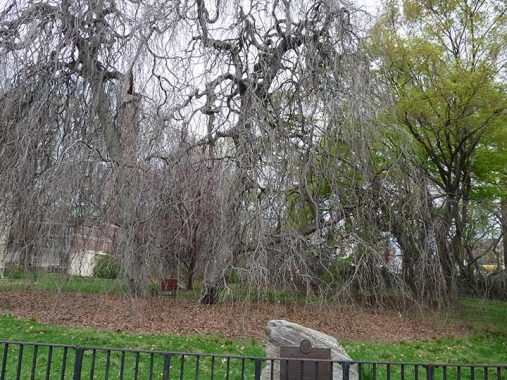
Flushing’s original Weeping Beech Tree was brought to Flushing from Belgium by Samuel Bowne Parsons in 1847 and planted on the grounds of the Parsons plant nursery. Kingsland Mansion, now home of the Queens Historical Society, was moved adjacent to the tree in the late 1920s (see below). The tree was declared a “living landmark” in 1966 and survived until 1997. Cuttings from the original tree ultimately produced the specimens you see not only in the original Weeping Beech’s old garden here, but in the Bowne Playground on Sanford Avenue and Union Street…in an auto customizing shop on Sanford Avenue and 162nd Street…and the Douglaston LIRR station on 235th Street!
It’s likely they all descend from that long-ago 1847 import from Belgium.
Kingsland Homestead
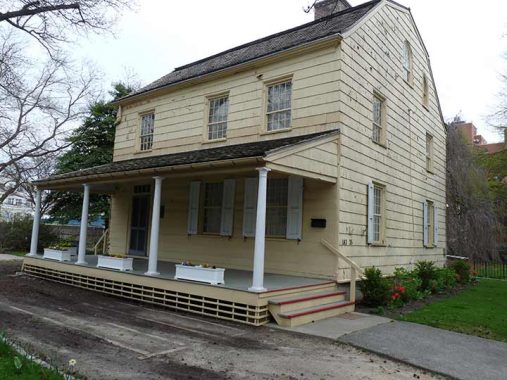
Amazingly, though Flushing can claim two buildings from the 17th century, the Bowne House (see below) and the Quaker Meetinghouse (Manhattan has none), 18th Century buildings are few and far between!
The Kingsland Homestead has been located in three sites since its construction in about 1790. In the 1920s it was moved to make way for the Flushing subway; before 1968 it was located at the southeast corner of Roosevelt Avenue and 155th Street, where it was beginning to become rundown. The Queens Historical Society had it moved to its present location on 37th Avenue, and the Society is housed in the homestead now.
Quaker Joseph Doughty constructed this building at about 1785-1790. It is named for his son-in-law, sea captain Joseph King, who bought it in 1802. It was later occupied by the Murray family, who gave their name to Murray Hill and Murray Street in east Flushing, well into the 20th Century. The interior of the homestead has been preserved pretty much as it was in the 19th century, and a public exhibit by the Queens Historical Society occupies much of the first floor that includes a representation of the Flushing Remonstrance. Kingsland is open from 2:30 – 4:30 PM Tuesday and Saturday, but you are advised to call ahead for an appointment at (718) 939-0647, ext 17. Prolific Queens author Jason Antos serves as its executive director. Some years ago I was beating Jason in Jeopardy! at Neir’s Tavern but he hit a pair of late Daily Doubles and I was sunk.
According to Ghosts of New York City chronicler Therese Lanigan-Schmidt, the presence of restless spirits has been noted in the old house over the past couple of centuries, but that’s old hat for Flushing: spooks apparently have troubled the Friends Meetinghouse and the John Bowne house as well!
(I agree with Popeye, though: “Ghosks Is the Bunk”)
Carman Green
At one time I believe 37th Avenue, or its old name, Washington Street, proceeded directly through to Bowne Street, but for many years it has been a pedestrian mall, Carman Green, between Kingsland Homestead, a playground and the Bowne House, named for Margaret Isabel Carman (1890-1976), a preeminent scholar on the history of Flushing and longtime teacher at Flushing High School.
Flushing Freedom Trail
Flushing is considered a bulwark in the cause of religious freedom in the USA (see Bowne House, below). Many years ago the Flushing Freedom Trail was established to link its historic sites and was marked by small red signs and a red stripe on the sidewalk that has since faded away. More recently these helpful signs have been installed showing the trail superimposed on a Flushing street map, with descriptions on the other side.
John Bowne House
“Full frontal” shots of the John Bowne house, Bowne Street at Carman Green, are hard to obtain for the layman as the grounds are often shuttered. However, during the holiday season a few years ago not only did I get on the grounds, I got inside, as many of the “Greatest Hits” are opened for a house tour in December. In recent years, things have opened up, and guided tours are available twice a week and on Sunday, May 19th, 2024.
Bowne House was built in 1661 by English settler John Bowne and, unlike many other colonial houses from the 17th and 18th centuries, it still looks a great deal like it did when it was built (though a coat of paint wouldn’t hurt).
Peter Stuyvesant, continuing his reign of terror against religious dissenters, had Bowne, a Quaker, arrested in 1662. Before the construction of the Friends Meetinghouse on Northern Boulevard in 1699, Bowne’s house was the primary site for Quaker services. Sentenced to pay a hefty fine, Bowne refused and was jailed; he was subsequently exiled to Holland.
While he was there, Stuyvesant’s bosses at the Dutch West India Company reversed Stuyvesant’s non-tolerant policy, claiming that the colony needed many immigrants to ensure economic expansion, no matter what faith they were. Bowne returned home to Flushing in 1664; the British sailed into New Netherland five months later, and Stuyvesant surrendered without a shot being fired.
Bowne’s illustrious descendants included Robert Bowne, who founded the still-extant Bowne & Co. financial printers; Walter Bowne, NYC mayor from 1829-1833; shipping magnate Robert Bowne Minturn; and abolitionist Mary Bowne Parsons, wife of horticulturalist Samuel Parsons, who may have used the Bowne House as an underground railroad way station.

The Queens Historical Society likely placed this historical sign with the aid of the William C. Pomeroy Foundation. A historical society I serve as a trustee, Newtown Historical, recently placed two similar signs at Lutheran-All Faiths Cemetery in Middle Village and at the site of the DeWitt Clinton house in Maspeth near Newtown Creek.
Bowne Street Community Church (Protestant Reformed Dutch Church)
This bell-towered brick church at Bowne Street and Roosevelt avenue (Amity Street) is late to the Landmarks Preservation Commission party and was designaed in 2009. As a result until recently I didn’t know much about it. Quoting from its LPC Report:
Originally built for the Protestant Reformed Dutch Church, this building is significant as an excellent example of the Romanesque Revival style, especially notable for its prominent corner tower, decorative brickwork, and opalescent stained-glass windows. Several of the windows were designed by artist and congregant Agnes Fairchild Northrop of Tiffany Studios. It is one of downtown Flushing’s most significant religious structures.
George E. Potter, an architect with a practice in Springfield, Massachusetts, and later in Hartford, Connecticut, most likely designed the church [completed in 1892].
The report is worth a read, plenty of Flushing information as well. Make a sandwich.
I’ll have to get to Flushing’s other Greatest Hits in Part Two sometime soon. It won’t include RKO Keith’s Theater, as its empty hulk was recently been torn down.
As always, “comment…as you see fit.” I earn a small payment when you click on any ad on the site. Take a look at the new JOBS link in the red toolbar at the top of the page on the desktop version, as I also get a small payment when you view a job via that link.
5/5/24


9 comments
Paradise Alley. I believe this was a bar called “Beggars Banquet” in the mid-70s. It was a “wine and cheese” bar, which was a thing at the time. The Rolling Stones theme was also evidenced by a similar-style 70’s establishment called “A Salt of the Earth” on Francis Lewis Boulevard just north of Northern Boulevard. That building burned down. The wine and cheese bar fadlet was over by 1980.
Great article. But the Kingsland Homestead is located in Weeping Beech Park, not Bowne Park.
As I’ve previously commented, I lived in this neighborhood, first on Roosevelt Ave. & Parsons Blvd 1972-74 & then on 38th Ave. in the Lincoln Gardens apartments, 1974-78. At this late date, what amazes me is that based on the photographs, very little seems to have changed. It still has the charm of a village which makes it a nice oasis in such an urban environment as NYC.
A former work supervisor attended a semester-long seminar with Allen Ginsberg when he was at Skidmore College in the 1970’s. She said he wouldn’t allow any vulgar language in the classroom and once sent a couple of girls* out to change when they were dressed too skimpily,
* = including, I strongly suspect, my former supervisor
Thanks for this new Greatest Hits series, Kevin!
And as always, thanks for preserving our precious local histories.
– from a former Staten Islander
A croffle is a cross between a croissant and a waffle. A cronut, on the other hand (in the other hand??) is a cross between a croissant and a donut.
feel free to delete my comment. got too excited about baked goods to read…
Great post Kevin!
My dad grew up in the Murray Hill Flushing area in the 1940’s and 50’s (33 Road off Triangle Park) after they moved from Forrest Av Bronx in the early 1940’s.
He passed in 1998 and I always think of him when he was a young kid/ man walking the streets of Flushing.
Wish he was here today….
Thank you for the amazing walks down memory lane sir!!
The practice of taking pictures of lampposts is baffling and amusing, for me at least, but I’ll leave it at that.